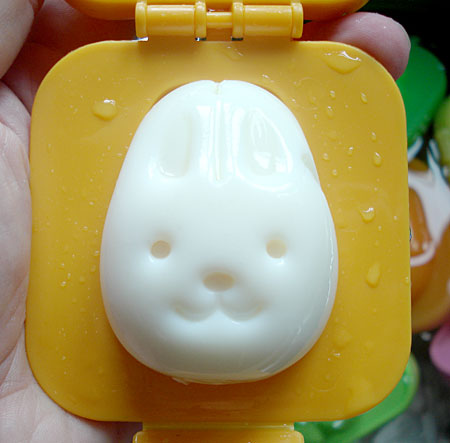Bento 101 (Getting Into the Bento Making Habit) Part 5: Keeping it going
Welcome to the last lesson of Bento 101: Getting Into The Bento Habit.
(Here's Academic Onigiri-man, back for an encore.)
![]()
During the last 4+ weeks we've:
- made a list of our favorite, lunch-able foods
- <a href=http://justbento.com/handbook/bento-courses-2013/bento-101-part-2a-what-do-i-put-it-in">practiced packing a meal into a box
- Learned how to select the right bento box or container(s) for our own, unique needs
- packed a real bento and brought it to school or work
- and worked on building up a 'bento stash'.
In Part 5, I'll talk about some ways to keep yourself motivated to make bentos on a regular basis.
Homemade bentos are great...for your health
We live in a world of abundance and convenience. But paradoxically, eating out all the time and maintaining your health can be as difficult as ever. Maybe you're lucky enough to have a place to eat near your work or school that makes great tasting, inexpensive lunches that only use fresh ingredients, lots of vegetables, only healthy oils and so on - and can deal with people with food sensitivities or allergies with no problem. Most of us aren't so lucky. In a lot of cases lunch is a hasty, greasy meal eaten on the run.
Spending a few minutes out of your day to pack yourself a healthy bento, that contains foods that you like, is a great way to take control of your health, especially if you have a specific goal in mind like losing weight, eating more vegetables, dealing with food allergies, and more. This applies if you are making bentos for your kids or other loved ones too.
Homemade bentos are great...for your finances
I have a confession to make. The last time I had a corporate job I was working 80+ hours a week, and I'm ashamed to say I ate almost all my meals out. I usually had a muffin and coffee or a bagel and coffee for breakfast, a sandwich or Chinese takeout for lunch (unless I went to a restaurant for a meeting or something); and because I was so tired at the end of the day I'd order a pizza or sushi or something for dinner, or go to the pub around the corner (mmm...shepherd's pie and Guinness). After a few years of this, one day I realized I just didn't have any money in the bank, even though I was making a pretty decent salary. It wasn't as if I was using my money for fun either (I went out maybe once a week, at most; most weekends I was just too tired to do anything but catch up on my sleep.) Where was my money going, aside from impulse purchases of books and things? Why, for all that takeout and bought food - half of which I didn't even enjoy. Plus it was making me fatter and fatter too.
So...at this point you might think I drastically changed my eating habits. That didn't quite happen actually ^_^; but I did make an effort to make at least one meal a day at home. I started with dinner, reviving my dormant passion for cooking, especially the food of my homeland- which indirectly, after a while, led to the start of my first food blog. Then I also started making my own lunch, for at least 1-2 days a week. It was usually something very simple like a sandwich, but I did occasionally make a bento too, using leftovers from dinner and so on. (In those days with my work schedule I couldn't really do much more than that.) And the difference it made to my finances was amazing.
One mind trick I used to play with myself was to put the money I would have spent on my favorite Chinese takeout lunch combo, or my favorite sandwich from the deli around the corner, usually around $5-8, vs. what I spent on a homemade bento, usualy $0-$2 at most on top of whatever I spent on dinner. I'd put whatever I would have spent on lunch into a jar. It was so fun to see the coins and small bills add up. (Although to be honest I didn't just let it accumulate as I should have - I dipped into it a lot when I needed change or cash!)
If you have a really busy life, it can seem almost impossible to think about packing your own lunch. Just try it though, even if it's just once a week. Even once every 2 weeks. Maybe try the coin-jar trick to see how much you save, or just do it on paper and keep track of your 'would have spent on eating out' money.
Why other people make bentos
A while back, I asked regular readers of this site why they make bentos. You can read their terrific responses here: Reasons why bento veterans make bentos. Maybe one of their stories will resonate with you.
A few more tips and and hacks for keeping it going
Besides things like setting aside part of dinner and building up a stash, here are some more ideas for keeping up a bento making habit:
1. If you're part of a couple, try sharing bento making duties
If your spouse or significant other and you both need bentos, one way to keep it going is to take turns making bentos. If you both cook anyway, it can be a whole lot of fun. We do this in our home; it started more or less during my illness, but we've kept it up now that I'm doing a lot better. (See The Guy Does Bento series for some of The Guy's favorites.)
2. Get your kids into it
Cooking with kids is fun, but I realize it doesn't always save time. But if your kids are old enough or responsible enough, have them contribute to, or even make, their lunches. This can be something as simple as making their own PB & J sandwich, or putting out the packing supplies for their lunch the night before. If you trust them with knives and cutters, what about having them prep the vegetables (my nephew used to love peeling carrots - he could peel them for hours), cutting up cheese, or if they're creative, even make an apple bunny? My sister tells me that my 11 year old niece Lena has discovered the joys of cooking, and is making cute onigiri (rice balls) for herself when she has a school outing.
3. Slack off once in a while
You may be all gung-ho and full of enthusiasm for making perfectly arranged bentos for yourself all the time. But I can tell you, it's not easy to keep it going every time. This is why I occasionally like to have a 'one-dish' type bento, such as the chana dal (just needs to be packed in a lunch jar) or non-bento bento like putting some cold cuts and salad greens in a box.
4. Have 2-3 favorite bento combos that you could make in your sleep
Trying out new recipes is fun, but time consuming. I have a couple of bento combinations that we both like, and which I can almost make blindfolded; they appear in the rotation the most by far. (I featured 3 of my heavy-rotation bentos in the Redbook feature - can you guess which ones?)
5. When you get stuck or bored - try a new bento box
This last tip rather goes against the "bentos help you save money" statement, and you do need to keep it under control. But I find that one of the best ways to get out of a bento rut is to get a new, cute or intriguing bento box. For instance, when I encountered the triangular Light My Fire lunchbox, I had so much fun figuring out bento combos that would take advantage of its unique shape, like this one.
6. Why not try making a charaben?
As you may have noticed, I'm all for practical, healthy and fast over cute and decorative when it comes to bentos. But once in a great while it can be fun to sit down and make a decorative 'character bento' or charaben. I had a lot of fun making the tiger faces on these corn muffins for example (described here):
Making molded boiled eggs is really time consuming so I rarely do it, but again - once in a while it's kind of fun - and believe me, adults love them as well as kids:
Further reading
We didn't get into all the aspects of making bentos, but it's already right here on the site. Take a look at the Bento Basics listing in the left sidebar of the page.
For safety tips (which we addressed briefly) see: Keeping your bento lunch safe, which is the definitive article on JustBento about the subject.
Conclusion
So..that does it for Bento 101! I hope you've enjoyed it, and learned a little along the way. I'll also have a roundup of the bentos and other assignment related photos people have posted during the course in a few days.
If you just found this course
If you missed the course, don't dismay: you can follow along with it at your own pace, and I'm always happy to answer your questions; just post them in the comments for the corresponding lesson. Start at this page, and follow the posts in sequence.
If you enjoyed this article, please consider supporting this site by becoming my patron via Patreon.



